|
|


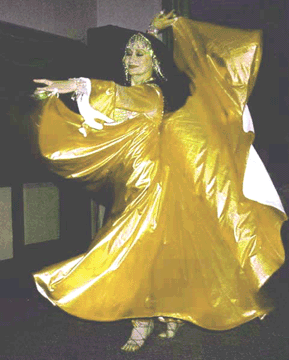
Prelude...
Have you seen her all in Gold,
Like a Queen in days of old?
She shoots colors all around,
Like a sunset going down;
Have you seen the Lady Pharaoh?
_from She's A Rainbow, by the Rolling Stones
The year was 1967 when the Stones stormed the top 40 airwaves with this wildly popular single. The elegantly spare composition has an evocative, haunting quality that can only be explained by the depth of feeling in the performance. Such words might just as accurately describe the great Raqs Sharqi dancer, Helena Vlahos. Given the time frame, it's entirely possible that Mick Jagger and company might have been inspired by seeing Helena in action. What in human experience conspires to produce such an individual? A precise answer is perhaps impossible, but by examining such a person's life experiences, we may find clues that will help guide us on our own paths. To those of you unfamiliar with Helena, read on for a wonderful, multi-faceted journey into the world of a living Belly Dance legend. For those of you who've had the pleasure of her acquaintance, here is an intimate portrait, sure to deepen your appreciation of her Art.
Raised on the Rhythm
 Off the northeast coast of the Greek state of Peloponnesos lies the tiny island of Hydra (or Ydra). Here in the spring of 1948 Helena Vlahos was born, surrounded by the crystalline blue Aegean Sea and sky. Though geographically a small island, Hydra is close to mainland cultural centers. Then home to about 3,000 residents the population of Hydra could swell to 7,000 during tourist season, bringing in welcome revenues and the benefits of contact with cosmopolitan influences. Helena recalls that the foreigners were regarded with something approaching the status of "gods". To the island's children, all foreigners, regardless of national origin, were thought to be Americans. The United States was at the height of its post-war glory, and its citizens were viewed as "having it all". Although many of the generous tourists were most certainly Europeans, the U.S. had nevertheless captured the Greek popular imagination Off the northeast coast of the Greek state of Peloponnesos lies the tiny island of Hydra (or Ydra). Here in the spring of 1948 Helena Vlahos was born, surrounded by the crystalline blue Aegean Sea and sky. Though geographically a small island, Hydra is close to mainland cultural centers. Then home to about 3,000 residents the population of Hydra could swell to 7,000 during tourist season, bringing in welcome revenues and the benefits of contact with cosmopolitan influences. Helena recalls that the foreigners were regarded with something approaching the status of "gods". To the island's children, all foreigners, regardless of national origin, were thought to be Americans. The United States was at the height of its post-war glory, and its citizens were viewed as "having it all". Although many of the generous tourists were most certainly Europeans, the U.S. had nevertheless captured the Greek popular imagination  Being right next door to the Arabic countries and having spent 400 years under Turkish rule, Greece is alive with the music and dance of the entire Middle East. Greek music, though a genre unto itself, shares many characteristics with Arabic music. Television had yet to arrive; an islander's life was instead punctuated by weddings, feasts, and holidays filled with joyous celebrations of song and dance. As a result, little Helena was immersed in a kaleidoscopic array of Middle Eastern melodies and rhythms. Being right next door to the Arabic countries and having spent 400 years under Turkish rule, Greece is alive with the music and dance of the entire Middle East. Greek music, though a genre unto itself, shares many characteristics with Arabic music. Television had yet to arrive; an islander's life was instead punctuated by weddings, feasts, and holidays filled with joyous celebrations of song and dance. As a result, little Helena was immersed in a kaleidoscopic array of Middle Eastern melodies and rhythms.
American dancers familiar with the Raqs Sharqi genre of Middle Eastern music will agree that the form is devilishly intricate, reeling with odd time signatures, improvisational accents, and abrupt transitions. But, just as we in America master our difficult language through early childhood experience, our Helena was fortunate to be imbued with the spirit of Arabic music. So that we might better appreciate her achievements, a closer look at her cultural milieu is in order.
Coming To America...
 When Helena was eight years old, her father moved the family to the United States, the "Land of Opportunity". They arrived in New York City after crossing the Atlantic by ship. Questioned on her first impression of the new world, she recalls being shocked by the city's incredible cultural melting pot. The tall buildings and busy traffic added to her surprise, giving her the sense that she'd be lost in this strange man-made jungle of concrete and noise. Like all children though, our young lady quickly adapted to her new environment once her family had chosen Los Angeles, California as their home. Late 1950's L.A. supported a small but closely-knit Greek-American community. Being fond of their native song and dance and familiar with the successful management of Dance Club/Restaurants, a good number of the families opened such venues. It was as a teenager in these clubs, in the company of her mentor FoFo De Milo, that Helena first really took notice of the Raqs Sharqi Dance form. She recalls that most of the dancers performing were American greats such as Aisha Ali and Antoinette, but that there were also occasionally shows featuring Middle Eastern natives like the famous Iklas Osman who was noted for her feats of grace on upturned drinking glasses. As Helena grew to adolescence, the world of La Danse was weaving its way into her heart. When Helena was eight years old, her father moved the family to the United States, the "Land of Opportunity". They arrived in New York City after crossing the Atlantic by ship. Questioned on her first impression of the new world, she recalls being shocked by the city's incredible cultural melting pot. The tall buildings and busy traffic added to her surprise, giving her the sense that she'd be lost in this strange man-made jungle of concrete and noise. Like all children though, our young lady quickly adapted to her new environment once her family had chosen Los Angeles, California as their home. Late 1950's L.A. supported a small but closely-knit Greek-American community. Being fond of their native song and dance and familiar with the successful management of Dance Club/Restaurants, a good number of the families opened such venues. It was as a teenager in these clubs, in the company of her mentor FoFo De Milo, that Helena first really took notice of the Raqs Sharqi Dance form. She recalls that most of the dancers performing were American greats such as Aisha Ali and Antoinette, but that there were also occasionally shows featuring Middle Eastern natives like the famous Iklas Osman who was noted for her feats of grace on upturned drinking glasses. As Helena grew to adolescence, the world of La Danse was weaving its way into her heart.
That's Entertainment...
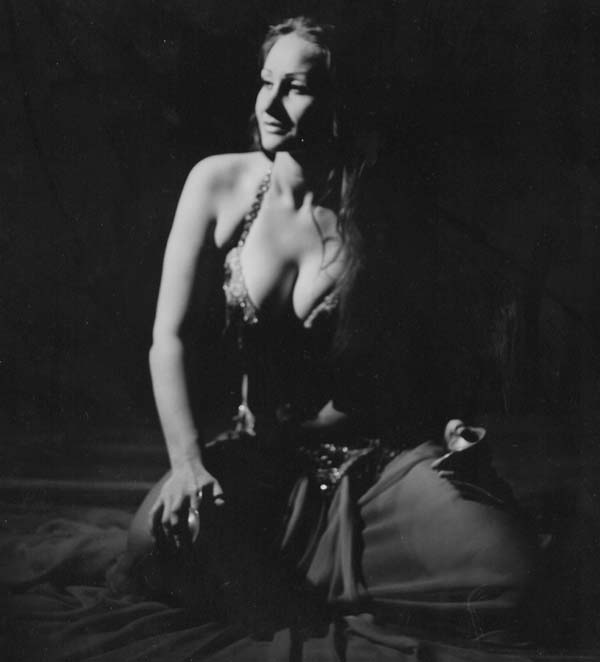 To the new generation of American Belly Dance students, Helena's preferred Raqs Sharqi music can be a confounding experience, and often leads to the question of "why ought I bother to dance to it". Aside from the gloriously beautiful Cabaret Bedleh (costume ensembles), the answer to this is simple if one takes the time to understand La Danse Orientale in its Arabic context. In Arabic countries, Raqs Sharqi is an honored tradition of entertainment, with family-oriented restaurants and clubs hosting full line-ups of both solo and troupe performers. Helena explains that, while physical and spiritual benefits to the dancer are undeniably a part of performance, Arabic culture values the Dance as a medium for the public display and appreciation of artistic virtuosity. Dedicated study of the Raqs Sharqi form gives one unparalleled spirit/mind/body integration, leading the dancer to a sense of fulfillment not only in herself, but also in her ability to add to the beauty of the world around her. A useful model for understanding the role of Raqs Sharqi dancers in the Middle East would be to compare them to American rock stars or athletes. They are cherished media icons in their countries, although perhaps not what a parent would dream of their child aspiring to be. The accomplished Raqs Sharqi performer is an athlete as much as an Artist, in that the degree of control required for mastery is only achieved through athletic discipline. If one has any doubts that this is so, they'll vanish after seeing Helena "do her thing"! To the new generation of American Belly Dance students, Helena's preferred Raqs Sharqi music can be a confounding experience, and often leads to the question of "why ought I bother to dance to it". Aside from the gloriously beautiful Cabaret Bedleh (costume ensembles), the answer to this is simple if one takes the time to understand La Danse Orientale in its Arabic context. In Arabic countries, Raqs Sharqi is an honored tradition of entertainment, with family-oriented restaurants and clubs hosting full line-ups of both solo and troupe performers. Helena explains that, while physical and spiritual benefits to the dancer are undeniably a part of performance, Arabic culture values the Dance as a medium for the public display and appreciation of artistic virtuosity. Dedicated study of the Raqs Sharqi form gives one unparalleled spirit/mind/body integration, leading the dancer to a sense of fulfillment not only in herself, but also in her ability to add to the beauty of the world around her. A useful model for understanding the role of Raqs Sharqi dancers in the Middle East would be to compare them to American rock stars or athletes. They are cherished media icons in their countries, although perhaps not what a parent would dream of their child aspiring to be. The accomplished Raqs Sharqi performer is an athlete as much as an Artist, in that the degree of control required for mastery is only achieved through athletic discipline. If one has any doubts that this is so, they'll vanish after seeing Helena "do her thing"!
Call of the Muse
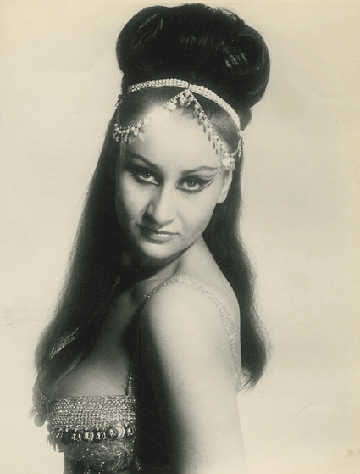 Once again, we briefly diverge for the sake of clarity. In ancient Greek culture, music was any form of inspired thinking. That is to say, along with the arts that westerners would consider musical such as Dance and Song, History, Literature and Science were also considered "music" (i.e., coming from inspiration by one of the nine mythological Muses). Even though the Golden Age of Athens has long since passed, the concept of Dance as a socially viable profession is deeply imbedded in the Greek psyche. So it's not terribly surprising that when Terpsichore, Muse of the Dance, beckoned to Helena, her family accepted her interest as natural and appropriate. Distant relative FoFo De Milo, a Greek-American dancer/entertainer and first owner of the Greek Village Restaurant in Hollywood, spotted young Helena dancing at family celebrations. FoFo sensed that Helena was a natural talent, and offered to give her dance instruction in exchange for help at her studio. Helena points out that, at the time, there was no such thing as a teacher only of Belly Dance. An aspiring dancer learned what she could by watching other dancers, asking questions when welcomed to, and studying with a Middle Eastern entertainer such as FoFo, who "did a little bit of everything", including some Belly Dance. So it was FoFo who began to teach Helena professionalism. Once again, we briefly diverge for the sake of clarity. In ancient Greek culture, music was any form of inspired thinking. That is to say, along with the arts that westerners would consider musical such as Dance and Song, History, Literature and Science were also considered "music" (i.e., coming from inspiration by one of the nine mythological Muses). Even though the Golden Age of Athens has long since passed, the concept of Dance as a socially viable profession is deeply imbedded in the Greek psyche. So it's not terribly surprising that when Terpsichore, Muse of the Dance, beckoned to Helena, her family accepted her interest as natural and appropriate. Distant relative FoFo De Milo, a Greek-American dancer/entertainer and first owner of the Greek Village Restaurant in Hollywood, spotted young Helena dancing at family celebrations. FoFo sensed that Helena was a natural talent, and offered to give her dance instruction in exchange for help at her studio. Helena points out that, at the time, there was no such thing as a teacher only of Belly Dance. An aspiring dancer learned what she could by watching other dancers, asking questions when welcomed to, and studying with a Middle Eastern entertainer such as FoFo, who "did a little bit of everything", including some Belly Dance. So it was FoFo who began to teach Helena professionalism. 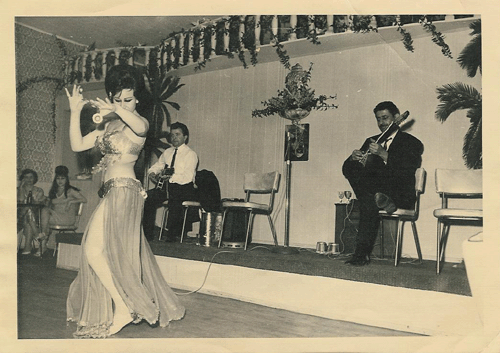 Helena poured her energies into learning about the world of Belly Dance with increasing fervor. Then in 1964, FoFo took her to see a newly opened club, the Athenian Restaurant in L.A. As was customary, the club's owner encouraged young ladies to get up and dance. Helena obliged, and the owner promptly invited her to dance at the restaurant's upcoming Grand Opening. A Star had been born in Southern California that night. Helena poured her energies into learning about the world of Belly Dance with increasing fervor. Then in 1964, FoFo took her to see a newly opened club, the Athenian Restaurant in L.A. As was customary, the club's owner encouraged young ladies to get up and dance. Helena obliged, and the owner promptly invited her to dance at the restaurant's upcoming Grand Opening. A Star had been born in Southern California that night.
Seizing the Night
A mad rush followed to get Helena ready for the impending show. Since she hadn't chosen a stage name for herself, the club's owner dubbed her "Zaida" and took her to one of the Hollywood movie studio costume shops to find something for her to wear. Helena recalls that the pickings were slim, with nothing authentically resembling good bedleh at all. She ended up with a showbiz-type improvisation on a Middle Eastern costume that she describes laughingly as a "fishing net" for a skirt, with pink chiffon underneath, accompanied by a "skimpy" bra and belt. Since the shop rented costumes for three days at a time, the owner extended her engagement to three days. Thus bedecked, our young lady was ready to meet her first audience.
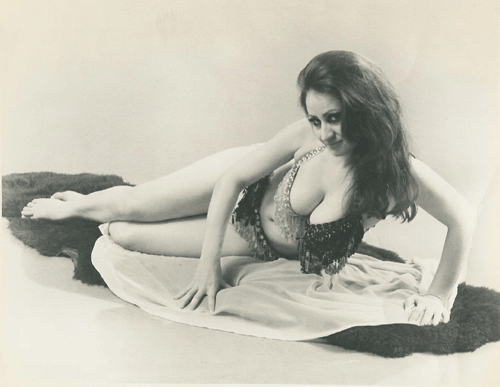 When questioned as to how she knew that Belly Dance was to be her career, she speaks of this night: "When I stepped on the floor, I think, my first step on there, I knew. I was very shy in school; if the teacher called on me I cringed, you know, my face would get all red if I had to answer questions. You'd never think it, I know, by talking to me, but that's exactly the way I was...I still am, in that kind of environment...but in the Dance I felt secure and in control...Of course when I danced that first time, I had greats like Rosalind Russell and Edward G. Robinson right there (in the audience); those two I really remember. Rosalind Russell to me looked so beautiful, and I'm sure I couldn't have been very good, but she was looking at me like I was the best dancer in the world. And I was getting such applause!" When questioned as to how she knew that Belly Dance was to be her career, she speaks of this night: "When I stepped on the floor, I think, my first step on there, I knew. I was very shy in school; if the teacher called on me I cringed, you know, my face would get all red if I had to answer questions. You'd never think it, I know, by talking to me, but that's exactly the way I was...I still am, in that kind of environment...but in the Dance I felt secure and in control...Of course when I danced that first time, I had greats like Rosalind Russell and Edward G. Robinson right there (in the audience); those two I really remember. Rosalind Russell to me looked so beautiful, and I'm sure I couldn't have been very good, but she was looking at me like I was the best dancer in the world. And I was getting such applause!"
An interesting event took place when the Bureau of Alcohol,Tobacco, and Firearms received an anonymous tip that a sixteen year old girl was performing at the club. Undercover agents showed up on the scene and questioned the club's owner about the age of their dancer. She replied that the young lady was twenty-five. Helena, who'd been in the dressing room came out, and the agents asked her how old she was. "Sixteen" she replied sweetly. They were not amused, and had to decide what to do with their juvenile charge. Finally, Helena was whisked off to the juvenile detention center where she a good many amused looks, then received a thorough scolding from the head Matron. Helena was released into her mother's custody, and told NOT to do it again until she was 21. Two weeks later, she was back onstage.
A Perfect Fit
When you have the full attention of just one spectator, you then have the whole audience.
__FoFo De Milo
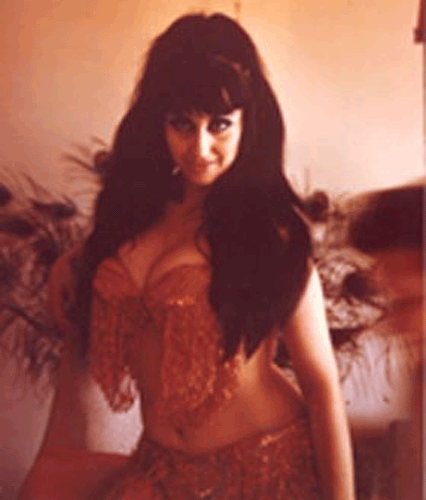 From that fateful night on, Helena has never looked back. Her career blossomed, and she enjoyed all the engagements she could possibly handle. Everything about the Belly Dance scene suited her to a tee; she looked mature enough even at sixteen to work the clubs (says with a laugh, "I've been this size since I was twelve!"), was a natural-born night owl, had an inborn affinity for the Dance, and a lovely sister, Maria, who later also became a dancer and could make beautiful, durable costumes that fitted well. For the first time in her life, Helena felt that she'd found a place where she truly belonged. She's quick to note with a chuckle, that like all young performers, she had quite an over-inflated ego in her first couple of years performing, and when she found out (mostly from her own sister's truthful comments) just how unpolished she could look, it was an extremely humbling experience! From that fateful night on, Helena has never looked back. Her career blossomed, and she enjoyed all the engagements she could possibly handle. Everything about the Belly Dance scene suited her to a tee; she looked mature enough even at sixteen to work the clubs (says with a laugh, "I've been this size since I was twelve!"), was a natural-born night owl, had an inborn affinity for the Dance, and a lovely sister, Maria, who later also became a dancer and could make beautiful, durable costumes that fitted well. For the first time in her life, Helena felt that she'd found a place where she truly belonged. She's quick to note with a chuckle, that like all young performers, she had quite an over-inflated ego in her first couple of years performing, and when she found out (mostly from her own sister's truthful comments) just how unpolished she could look, it was an extremely humbling experience! 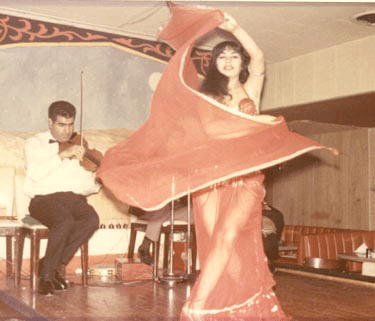 At one point, an elderly Middle-Eastern patron took her aside and told her she "ought to learn to use her hands, like Marliza (Pons)", and although this left our young lady somewhat incensed at the "old geezer", a bit of self-observation led her to recognize the truth in his words. Early on, like so many dancers, not using her hands to complement her moves was a weak spot. So, wisely valuing progress over pride, the fledgling entertainer learned to be open to the gifts of well-intended criticism. Later on, Helena was fortunate enough to befriend the fabulous Marliza , who disclosed that "someone" had suggested to her that she might help Helena with her dance! Helena remains very fond of Marliza to this day, recalling her as a superb performer with an incredible shimmy. She says with a smile, "Marliza could shake and yawn at the same time!" At one point, an elderly Middle-Eastern patron took her aside and told her she "ought to learn to use her hands, like Marliza (Pons)", and although this left our young lady somewhat incensed at the "old geezer", a bit of self-observation led her to recognize the truth in his words. Early on, like so many dancers, not using her hands to complement her moves was a weak spot. So, wisely valuing progress over pride, the fledgling entertainer learned to be open to the gifts of well-intended criticism. Later on, Helena was fortunate enough to befriend the fabulous Marliza , who disclosed that "someone" had suggested to her that she might help Helena with her dance! Helena remains very fond of Marliza to this day, recalling her as a superb performer with an incredible shimmy. She says with a smile, "Marliza could shake and yawn at the same time!"
Shakin' at Shakour's
 It was about six months after her debut that Helena caught the eye of another club owner, this time at Shakour's Oasis in Hollywood. Helena , now given the stage name "Shadia", continued to dance three nights at the Athenian, and now booked on at the Oasis for an additional three. She regards her time spent at Shakour's as a pivotal point in her development. It was there that she had the pleasure of having musicians especially devoted to creating a rapport with the movements of her dance. One standout favorite was the sessions she spent with Oud master Khamis El Fino Ali, who'd pull attenuated sounds out of his instrument in complement to Helena's belly roll displays. Equally delightful were the playfully expressive vocalizations of the great Najib Khoury. Such experiences as these gave her a hold on a now often overlooked dimension of performance art. It was about six months after her debut that Helena caught the eye of another club owner, this time at Shakour's Oasis in Hollywood. Helena , now given the stage name "Shadia", continued to dance three nights at the Athenian, and now booked on at the Oasis for an additional three. She regards her time spent at Shakour's as a pivotal point in her development. It was there that she had the pleasure of having musicians especially devoted to creating a rapport with the movements of her dance. One standout favorite was the sessions she spent with Oud master Khamis El Fino Ali, who'd pull attenuated sounds out of his instrument in complement to Helena's belly roll displays. Equally delightful were the playfully expressive vocalizations of the great Najib Khoury. Such experiences as these gave her a hold on a now often overlooked dimension of performance art.
A short time later, Helena was hired to dance at another restaurant. Again the name change issue came up. The orchestra leader asked her name, and she said "Shadia". He said, "No, no, no, no! We're going to call you"-, but, tired of all the name-swapping, Helena stopped him in mid-sentence and said, "My name is Helena and that's what I want to be called!" And such it has been ever since.
Viva Las Vegas!
From L.A. to Hollywood, up and down the California coast, to Houston and Austin, Texas, spots in Ohio and Georgia, and even Hong Kong, Helena's Dance has taken her to many wonderful places. The American West remains her favorite region, however.
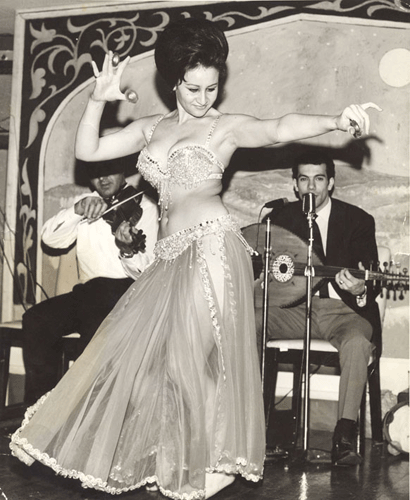 To chronicle her career club by club, year by year, would produce such a long list that it'd make tedious reading, and that wouldn't even take into account the innumerable private parties. Some of the more famous spots were places such as the already-mentioned Athenian Restaurant and Shakour's Oasis, as well as the Fez, the Seventh Veil, the Egyptian Gardens, and the Greek Village. Suffice it to say that she swept across the floors of nearly every important West Coast Middle Eastern dance club of the 60's, and 70's, and 80's, as well as a generous sampling of venues in other parts of the U.S. An early high point in her career came in 1966 when she opened in Las Vegas at the Aladdin as the featured dancer with the very popular concert violinist, Hrach Yacoubian. Vegas was and still is, her most favorite place to perform. "They have everything there", she explains, meaning full facilities to accommodate the needs of performers. By that time, her sister Maria was adept at creating exquisitely beaded bedleh costumes, an Art that Helena eventually took up herself. To this day, she pours her very good taste into the design and construction of exquisite, one-of-a-kind bedleh ensembles that rank as outstanding examples of the costumer's Art. Las Vegas, she recounts, is a costumer's heaven. Huge sums of money are poured into outfitting the performers, and no expense is spared in either materials or workmanship, much like the days of Old Hollywood. To chronicle her career club by club, year by year, would produce such a long list that it'd make tedious reading, and that wouldn't even take into account the innumerable private parties. Some of the more famous spots were places such as the already-mentioned Athenian Restaurant and Shakour's Oasis, as well as the Fez, the Seventh Veil, the Egyptian Gardens, and the Greek Village. Suffice it to say that she swept across the floors of nearly every important West Coast Middle Eastern dance club of the 60's, and 70's, and 80's, as well as a generous sampling of venues in other parts of the U.S. An early high point in her career came in 1966 when she opened in Las Vegas at the Aladdin as the featured dancer with the very popular concert violinist, Hrach Yacoubian. Vegas was and still is, her most favorite place to perform. "They have everything there", she explains, meaning full facilities to accommodate the needs of performers. By that time, her sister Maria was adept at creating exquisitely beaded bedleh costumes, an Art that Helena eventually took up herself. To this day, she pours her very good taste into the design and construction of exquisite, one-of-a-kind bedleh ensembles that rank as outstanding examples of the costumer's Art. Las Vegas, she recounts, is a costumer's heaven. Huge sums of money are poured into outfitting the performers, and no expense is spared in either materials or workmanship, much like the days of Old Hollywood.
A Happy Accident
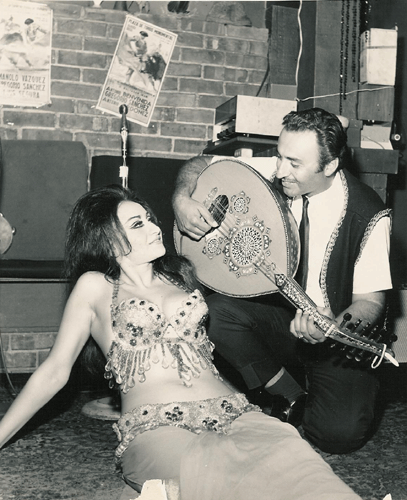 Sometimes our best ideas are born when we least expect it. Helena relates that just such an occasion gave rise to the act that put her into the Guinness Book Of World Records and earned her quite a bit more than Mr. Warhol's touted 15 minutes of fame. The famous act involves first flipping a dollar bill in the crease of her belly. Then she proceeds to lay out a row of nine quarters across her tummy just below her navel. Using her belly muscles, she flips the quarters; twice up and down, one at a time, and finally every other one at a time! When asked how this came about, Helena takes us back to a performance in 1968 at the People Tree in Calabasas, California Sometimes our best ideas are born when we least expect it. Helena relates that just such an occasion gave rise to the act that put her into the Guinness Book Of World Records and earned her quite a bit more than Mr. Warhol's touted 15 minutes of fame. The famous act involves first flipping a dollar bill in the crease of her belly. Then she proceeds to lay out a row of nine quarters across her tummy just below her navel. Using her belly muscles, she flips the quarters; twice up and down, one at a time, and finally every other one at a time! When asked how this came about, Helena takes us back to a performance in 1968 at the People Tree in Calabasas, California 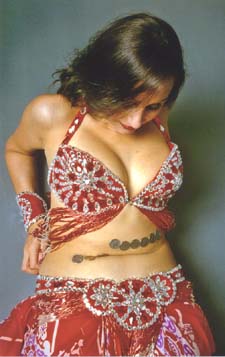 br />
Since Helena had taught herself to perform belly rolls while reclining with her arms propping her up, she incorporated the position into the belly roll segment of her act. Naturally, appreciative patrons would shower her with tips as she performed. Then on this particular night, a customer placed a bill right where it caught perfectly in her belly fold, causing the note to flip neatly over. The crowd went wild! Helena realized that here was something really cute she could add to her show..With her typical determined attitude, she began to practice the act in her spare time. At first she worked only with the bill, but then thought, why not give coins a try. After experimenting with various coins, she settled on quarters as working the best for her. Years of persistence finally led to her mastery of an incredible nine coin row, a feat that hasn't been matched since. br />
Since Helena had taught herself to perform belly rolls while reclining with her arms propping her up, she incorporated the position into the belly roll segment of her act. Naturally, appreciative patrons would shower her with tips as she performed. Then on this particular night, a customer placed a bill right where it caught perfectly in her belly fold, causing the note to flip neatly over. The crowd went wild! Helena realized that here was something really cute she could add to her show..With her typical determined attitude, she began to practice the act in her spare time. At first she worked only with the bill, but then thought, why not give coins a try. After experimenting with various coins, she settled on quarters as working the best for her. Years of persistence finally led to her mastery of an incredible nine coin row, a feat that hasn't been matched since.
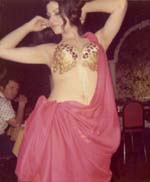 During this period, Helena mentored her first successful protégé , an exquisitely pretty Lebanese woman named Dahad Elias. To this day, they remain good friends, sharing phone conversations and cherishing visits whenever their paths cross. During this period, Helena mentored her first successful protégé , an exquisitely pretty Lebanese woman named Dahad Elias. To this day, they remain good friends, sharing phone conversations and cherishing visits whenever their paths cross.
"The Love of my Life"
Over the next few years, Helena's combination of performance virtuosity with her unique coin act earned her enormous popularity and her passion for the Dance was all-consuming. Club owners vied for her bookings, and in1971 she received a fabulous offer to work at the Bacchanal in Houston, Texas. The club offered superb dance facilities along with the much-treasured live musicians. Here she met and married Aleko Papageorgiou the bartender at the club. The marriage proved to be an unhappy match. Even the ensuing divorce had a happy ending though, when as she says, "the Love of my Life", her little daughter Daphne, was born on August 25, 1974. Helena's mother came to Houston to live and help care for Daphne during Helena's evening performances. 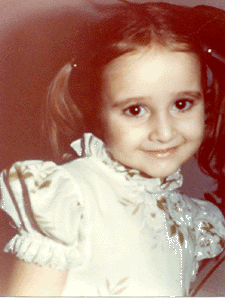 As Daphne grew up, she enjoyed watching her mother perform, but never considered the dance as a career for herself. Though she enjoyed a wide variety of performing arts classes, including some Belly Dance classes for children, Daphne has grown to be most interested in Acting and Fashion Merchandising. Asked about the impact of motherhood on her career, Helena says she treasures her experience of being a mother, and that it has touched her more deeply than anything else in her life. As she carried Daphne, she continued to dance until 5 ½ months, when she could feel it was time to slow down and make ready for her little one. Pictures of Helena at Daphne's infancy show her glowing with an ethereal beauty as she holds her little Love. Helena and Daphne continue to share a deep and affectionate bond, with Daphne referring to her mother as "her hero and her best friend". As Daphne grew up, she enjoyed watching her mother perform, but never considered the dance as a career for herself. Though she enjoyed a wide variety of performing arts classes, including some Belly Dance classes for children, Daphne has grown to be most interested in Acting and Fashion Merchandising. Asked about the impact of motherhood on her career, Helena says she treasures her experience of being a mother, and that it has touched her more deeply than anything else in her life. As she carried Daphne, she continued to dance until 5 ½ months, when she could feel it was time to slow down and make ready for her little one. Pictures of Helena at Daphne's infancy show her glowing with an ethereal beauty as she holds her little Love. Helena and Daphne continue to share a deep and affectionate bond, with Daphne referring to her mother as "her hero and her best friend".
Texas Taxim
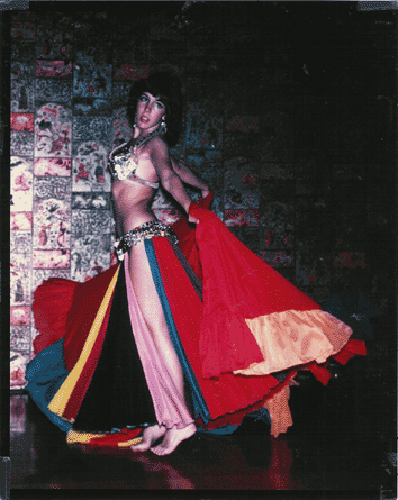 Helena enjoyed the time she spent in Houston, and was doing well until the club's owner, Ari Varoutsos made up his mind to help her open a dance school she'd mentioned wanting to try. The school became a reality. The space on the second floor of the club was converted to a very nicely furnished studio, and "Helena's School of belly Dance" was heralded in the local press. Students came eagerly, but Helena hadn't realized how taxing teaching would be in addition to her first love, performance. Helena enjoyed the time she spent in Houston, and was doing well until the club's owner, Ari Varoutsos made up his mind to help her open a dance school she'd mentioned wanting to try. The school became a reality. The space on the second floor of the club was converted to a very nicely furnished studio, and "Helena's School of belly Dance" was heralded in the local press. Students came eagerly, but Helena hadn't realized how taxing teaching would be in addition to her first love, performance. 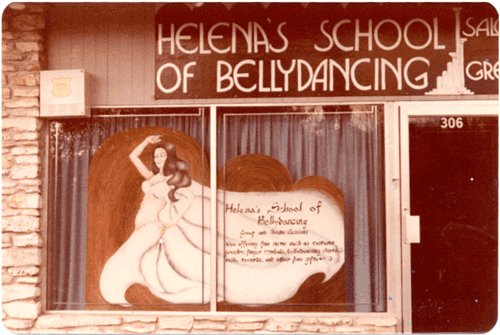 Knowing that to continue in her dance was vital to her, she made the difficult choice of handing operation of the school over to her much-beloved second protégé, the beautiful Mahal. It was a happy parting, and Mahal went on to great success as both dancer and instructor, thanks to Helena's initiative. Soon after the school changed hands, Helena moved yet again, this time to Austin. Here again, she opened a school, but this time on a smaller, part-time basis. Success came again, and yet again she grew restless. A party was held for changing of the keys, where Helena presented the keys to the now famous dancer Maria Amaya. Knowing that to continue in her dance was vital to her, she made the difficult choice of handing operation of the school over to her much-beloved second protégé, the beautiful Mahal. It was a happy parting, and Mahal went on to great success as both dancer and instructor, thanks to Helena's initiative. Soon after the school changed hands, Helena moved yet again, this time to Austin. Here again, she opened a school, but this time on a smaller, part-time basis. Success came again, and yet again she grew restless. A party was held for changing of the keys, where Helena presented the keys to the now famous dancer Maria Amaya.
L.A. Woman
The lure of her beloved Los Angeles holds sway over Helena, and in 1978 she and Daphne and grandma returned. It was in L.A. in 1981 that a good friend spread the buzz to the local media about Helena's Nine Quarters act. The description of her feat got the attention of Regis Philbin, who at the time hosted the local morning chat show, A.M. Los Angeles. Soon a phone call came inviting her to appear on the show and perform her act. Though naturally terrified, her performance instinct triumphed, and our Helena made her first TV appearance. The act was such a hit with the Hollywood crowd that media greats started scrambling to get Helena on their shows.
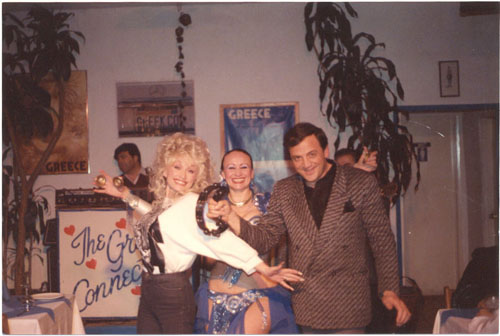 A flurry of television spots followed; first, The Merv Griffin Show, then The Mike Douglas Show, That's Incredible!, Here's Richard (Richard Simmons), Thicke of the Night, Regis Philbin Healthstyles, and finally Spectacular World of Guiness Records. Also to follow was a nice cameo role in an episode of Dynasty, plus a spot appearance in the Allan Carr film "Can't Stop the Music". A flurry of television spots followed; first, The Merv Griffin Show, then The Mike Douglas Show, That's Incredible!, Here's Richard (Richard Simmons), Thicke of the Night, Regis Philbin Healthstyles, and finally Spectacular World of Guiness Records. Also to follow was a nice cameo role in an episode of Dynasty, plus a spot appearance in the Allan Carr film "Can't Stop the Music". 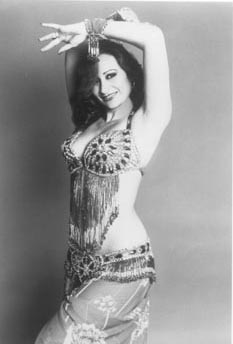 Of this period, Helena says that it "all happened in such a flash", and that while she certainly got quite a lot of exposure, nothing approaching the celebrity of Middle Eastern dancers in their native countries ever materialized for her here in the U.S. After spending about ten more years in L.A., Helena came to Phoenix, Arizona to provide Daphne with a safer place to spend her adolescence. Daphne graduated from High School then pursued college degrees in Phoenix and New York City, finally returning to L.A. for the good career opportunities. Luckily for local dancers, Helena chooses to remain here in Phoenix, where the Arizona Middle Eastern Dance Association (AMEDA) treasures her as the jewel in their crown. She's very quick to point out that the fondness is mutual. Helena says that she's forever grateful to so many Phoenix-area dancers and friends of the dance for the multitude of kindnesses they've extended to her, since learning that she was in residence here. It warms her heart to think of all these hard-working people who pour their efforts into bringing the best of Middle Eastern Dance culture to life, and she wants them to know that every act, every kind thought, every outreach is a precious gift. Of this period, Helena says that it "all happened in such a flash", and that while she certainly got quite a lot of exposure, nothing approaching the celebrity of Middle Eastern dancers in their native countries ever materialized for her here in the U.S. After spending about ten more years in L.A., Helena came to Phoenix, Arizona to provide Daphne with a safer place to spend her adolescence. Daphne graduated from High School then pursued college degrees in Phoenix and New York City, finally returning to L.A. for the good career opportunities. Luckily for local dancers, Helena chooses to remain here in Phoenix, where the Arizona Middle Eastern Dance Association (AMEDA) treasures her as the jewel in their crown. She's very quick to point out that the fondness is mutual. Helena says that she's forever grateful to so many Phoenix-area dancers and friends of the dance for the multitude of kindnesses they've extended to her, since learning that she was in residence here. It warms her heart to think of all these hard-working people who pour their efforts into bringing the best of Middle Eastern Dance culture to life, and she wants them to know that every act, every kind thought, every outreach is a precious gift.
Oops! The Worst of...
As any good performer knows, a sense of humor is essential to a successful career. Much as we try to do our best, life will inevitably throw the spotlight on us, just when we're making complete, if unintended, fools of our selves! Perhaps the first thing that strikes you about Helena aside from the absolute graciousness of her bearing is her humanity. This woman can laugh at herself, and heartily, too. So when asked to relate some of her worst moments, she first says, "Oh, but there've been so many!" Then after thinking for a moment obliges with some real good ones. Such as:
Her worst performance nightmare---The place was the Barefoot Bar of the Vacation Village Hotel at Mission Bay in San Diego, and Helena found herself elected to do the "Sultan Act" (getting a man from the audience to join her onstage). She relates that she's never been fond of this bit, but that it was unavoidably her turn, so she selected her "victim" and got him up on the stage, which was quite small for two people. Everything was fine till she gave the fellow a side bump with her hip to get laughs; and he unexpectedly reciprocated with a sharp return bump that threw her off balance. Her arms flailed down and out as she struggled to avoid falling into the audience; then all of a sudden her hand got hold of a soft mass of fabric and flesh: his crotch, to which she unwittingly proceeded to hang onto for dear life. Needless to say, the audience was amused, but she was mortified!
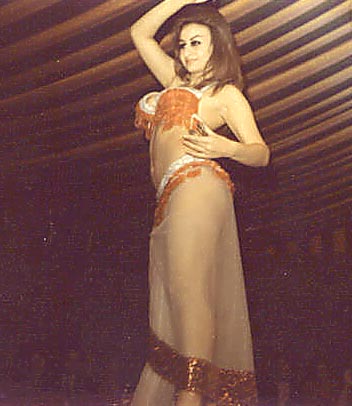 Her worst costume fiasco---Late in the 60's, the fashion in Belly Dance skirts was to have a 5" wide band of sequin trim across the hemline. During Helena's engagement in Las Vegas, she was dressing to go onstage one night with only a few minutes to spare. The dressing rooms were located in the basement due to a quirk in the building's construction. Bra, belt, skirt, and veil at the ready, our heroine flew out the door and up the steps when lo and behold, she heard a sickening rrrrip! Looking down she saw approximately five feet of her sequined hemline hanging askew. Panic set in, as her number was about to start. She says, "I flew back down those stairs, and thank goodness, there were other girls in the show who took one look, then completely stripped and redressed me in what must've been thirty seconds time. I was shaking like a leaf as I ran back up the stairs and made it onto the stage just in time. That's one performance where I was covered in sweat before I even began to dance!" Her worst costume fiasco---Late in the 60's, the fashion in Belly Dance skirts was to have a 5" wide band of sequin trim across the hemline. During Helena's engagement in Las Vegas, she was dressing to go onstage one night with only a few minutes to spare. The dressing rooms were located in the basement due to a quirk in the building's construction. Bra, belt, skirt, and veil at the ready, our heroine flew out the door and up the steps when lo and behold, she heard a sickening rrrrip! Looking down she saw approximately five feet of her sequined hemline hanging askew. Panic set in, as her number was about to start. She says, "I flew back down those stairs, and thank goodness, there were other girls in the show who took one look, then completely stripped and redressed me in what must've been thirty seconds time. I was shaking like a leaf as I ran back up the stairs and made it onto the stage just in time. That's one performance where I was covered in sweat before I even began to dance!"
A Dream Come True
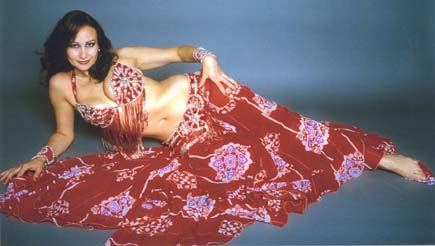 Turning the topic around, Helena recalls her fondest moment as being the time she was booked as the entertainer for Mohammed Ali's private 40th birthday party at his estate in Hancock Park. Having asked for directions to the house at the sentry booth, Helena was somewhat dismayed to see that a heavy fog was obscuring all the beautiful houses she'd so longed to see up close. But she found the house, and Ali's beautiful African-American wife at the time, Veronica, escorted Helena upstairs to the master bedroom where they both could change. Veronica explained that it was a stag party, but that she was "sneaking in" in a little maid uniform as a coffee server so that she could enjoy the festivities as well. The thrill for Helena came when she went to meet her audience for the evening. Sitting there right in front of her, besides Muhammed Ali, was none other than her girlhood screen idol, Cary Grant! Other great stars populated the room as well, such as John Travolta ("he has the most incredible eyes in person", she notes) Kris Kristofferson, and mayor Bradley. Conversations flowed, and her performance went off beautifully, but the whole evening she was all a-tingle with the thought that Cary Grant was there in the flesh, a dream come true! Turning the topic around, Helena recalls her fondest moment as being the time she was booked as the entertainer for Mohammed Ali's private 40th birthday party at his estate in Hancock Park. Having asked for directions to the house at the sentry booth, Helena was somewhat dismayed to see that a heavy fog was obscuring all the beautiful houses she'd so longed to see up close. But she found the house, and Ali's beautiful African-American wife at the time, Veronica, escorted Helena upstairs to the master bedroom where they both could change. Veronica explained that it was a stag party, but that she was "sneaking in" in a little maid uniform as a coffee server so that she could enjoy the festivities as well. The thrill for Helena came when she went to meet her audience for the evening. Sitting there right in front of her, besides Muhammed Ali, was none other than her girlhood screen idol, Cary Grant! Other great stars populated the room as well, such as John Travolta ("he has the most incredible eyes in person", she notes) Kris Kristofferson, and mayor Bradley. Conversations flowed, and her performance went off beautifully, but the whole evening she was all a-tingle with the thought that Cary Grant was there in the flesh, a dream come true!
Hints 'n Tips
NEVER go out with a club owner, a musician that you're working with, or a customer.
__FoFo De Milo
Helena passes on the above advice, noting that she herself didn't listen to this very wise counsel and ended up paying for it with painful experiences. With a club owner, she says, if he gets mad at you, you're out of a job; with the musician, if he gets mad at you he'll play lousy when you dance; and with the customer, jealousies often arise, leaving the owner out of a customer, and the dancer out of the customer's tips and possibly the job, too. This leaves the serious dancer with few opportunities for romance, but c'est la vie...
What should a dancer always take along to a job? The most important thing, according to Helena, is a list that you prepare ahead of time. Give yourself some quiet time to think about what you'll need, then write it down. Going over the list just before you leave means you'll be less likely to wind up missing necessary items at the job.
Two items that always go with her are SAFETY PINS and a SPARE COSTUME!
The Vanishing Venue
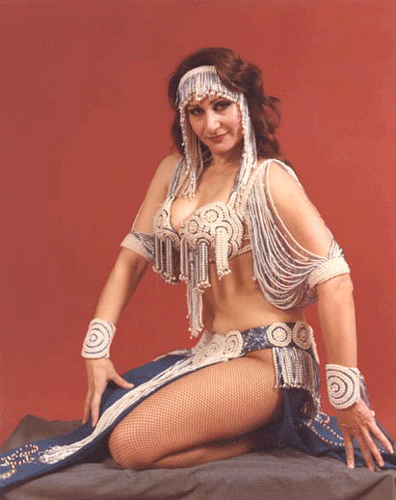 We come now to an issue of concern for all our readers: the disappearance of good places for dancers to perform. While the reasons why the venues are vanishing is material for a whole other essay, the fact remains that since Helena began her career, clubs with facilities to showcase Middle Eastern Dancers and live Middle Eastern musicians have dwindled to an alarming degree. Nightclub productions of the Dance as found in the native Middle Eastern countries are all but vanished in the United States. Discussing this topic, Helena doesn't hide her sadness; it shows in her eyes and in the tone of her normally lively dialogue. Thirty-six years in the Dance, Helena has been witness to the slow but steady exit of one good club after another. Things such as a clean, simple dressing area separate from customer restrooms; a stage with adequate floor space to perform the whirling ecstasies of veil work; a live ensemble of accomplished, Middle Eastern musicians; good lighting that complements the Dancer's appearance; all these features so essential to the Art are now very rarely encountered. The Dance in America lives now, says Helena, through the dedication of the performers who work hard to keep it alive. In place of the clubs, there has been an explosion of workshops, seminars, and dancer-sponsored festivals. While such activities are a welcome respite for those who love the dance, the loss of the clubs and the public appreciation of the Art is a great cultural tragedy. We come now to an issue of concern for all our readers: the disappearance of good places for dancers to perform. While the reasons why the venues are vanishing is material for a whole other essay, the fact remains that since Helena began her career, clubs with facilities to showcase Middle Eastern Dancers and live Middle Eastern musicians have dwindled to an alarming degree. Nightclub productions of the Dance as found in the native Middle Eastern countries are all but vanished in the United States. Discussing this topic, Helena doesn't hide her sadness; it shows in her eyes and in the tone of her normally lively dialogue. Thirty-six years in the Dance, Helena has been witness to the slow but steady exit of one good club after another. Things such as a clean, simple dressing area separate from customer restrooms; a stage with adequate floor space to perform the whirling ecstasies of veil work; a live ensemble of accomplished, Middle Eastern musicians; good lighting that complements the Dancer's appearance; all these features so essential to the Art are now very rarely encountered. The Dance in America lives now, says Helena, through the dedication of the performers who work hard to keep it alive. In place of the clubs, there has been an explosion of workshops, seminars, and dancer-sponsored festivals. While such activities are a welcome respite for those who love the dance, the loss of the clubs and the public appreciation of the Art is a great cultural tragedy.
Passion and Hope
 By this time, a good sketch of Helena's character has emerged. We see a beautiful, mature woman with a dauntless spirit and the grace, humor and polish that can only come from Life's refining forces. Dedicated to learning, Helena has continuously reached out to educational opportunities that suited her. She has taken instruction in Flamenco and Ballet dance forms to aid her in the Belly Dance, and attended countless seminars and workshops. In 1987, driven by the desire to learn the underpinnings of the establishments on which her Art depends, she completed a degree in Restaurant Management at the American College of Hotel and Restaurant Management in Los Angeles. In 1990 Helena moved to Phoenix, AZ where she worked as assistant manager of the upscale Christo's Ristorante. Helena continued to enjoy performing occasionally at private parties as well as at the few surviving Phoenix-area venues. She taught selected students privately at her home and produces splendid, fully accessorized bedleh costumes on a very limited basis. It is her dearest hope for the future that club owners and the Dance community will once again thrive as Belly Dance comes into a seeming new age of popularity, perhaps even achieving the public understanding necessary to effect the appreciative environment of the native Middle Eastern clubs. In all of this she sees the internet as holding out the greatest potential to help spread such an understanding. We're behind you 150% Helena, BRAVO Lady Pharaoh! By this time, a good sketch of Helena's character has emerged. We see a beautiful, mature woman with a dauntless spirit and the grace, humor and polish that can only come from Life's refining forces. Dedicated to learning, Helena has continuously reached out to educational opportunities that suited her. She has taken instruction in Flamenco and Ballet dance forms to aid her in the Belly Dance, and attended countless seminars and workshops. In 1987, driven by the desire to learn the underpinnings of the establishments on which her Art depends, she completed a degree in Restaurant Management at the American College of Hotel and Restaurant Management in Los Angeles. In 1990 Helena moved to Phoenix, AZ where she worked as assistant manager of the upscale Christo's Ristorante. Helena continued to enjoy performing occasionally at private parties as well as at the few surviving Phoenix-area venues. She taught selected students privately at her home and produces splendid, fully accessorized bedleh costumes on a very limited basis. It is her dearest hope for the future that club owners and the Dance community will once again thrive as Belly Dance comes into a seeming new age of popularity, perhaps even achieving the public understanding necessary to effect the appreciative environment of the native Middle Eastern clubs. In all of this she sees the internet as holding out the greatest potential to help spread such an understanding. We're behind you 150% Helena, BRAVO Lady Pharaoh!
Update
 Helena has come back full time to her beloved dance. She is on the Executive Panel of Judges for Tonya & Atlantis’ Belly Dancer of the Universe Competition every February in Long Beach, California since 2005. Helena has mentored dancers who have gone on to win titles in competitions including the BDUC. Helena has come back full time to her beloved dance. She is on the Executive Panel of Judges for Tonya & Atlantis’ Belly Dancer of the Universe Competition every February in Long Beach, California since 2005. Helena has mentored dancers who have gone on to win titles in competitions including the BDUC.
Helena taught classes at Paradise Valley Community College, Glendale Community College, Phoenix College, Belly Dance 4 Me studio, Plaza de Anaya, The Sanctuary Resort, Biltmore Resort, Camelback Village Health Spa and many more. She also found time to perform at the Bacchanal Greek Restaurant in Phoenix.
Helena graced the covers of two magazines: “Studioâ€, A Quarterly Journal of Folk & International Music & Dance in January 2006 and “Belly Danceâ€, A Raqs Sharqi Magazine in the summer 2008 Issue. She is also a featured dancer in a new DVD “American Belly Dance Legends†produced by Amaya and in Damon the Gypsy's DVD "Dance Little Gypsy".
She is the recipient of MECDA’s Arizona Lifetime Achievement Award 2011 and was nominated MECDA’s Favorite Arizona Cabaret/Oriental Dancer 2011.
Helena moved back to Los Angeles in the fall of 2011, where she teaches and performs when not traveling for master workshops.

Contact Helena: helenavlahosdance@gmail.com
Written by Niama (Norma Westover)
Television and Film Appearances
|





Off the northeast coast of the Greek state of Peloponnesos lies the tiny island of Hydra (or Ydra). Here in the spring of 1948 Helena Vlahos was born, surrounded by the crystalline blue Aegean Sea and sky. Though geographically a small island, Hydra is close to mainland cultural centers. Then home to about 3,000 residents the population of Hydra could swell to 7,000 during tourist season, bringing in welcome revenues and the benefits of contact with cosmopolitan influences. Helena recalls that the foreigners were regarded with something approaching the status of "gods". To the island's children, all foreigners, regardless of national origin, were thought to be Americans. The United States was at the height of its post-war glory, and its citizens were viewed as "having it all". Although many of the generous tourists were most certainly Europeans, the U.S. had nevertheless captured the Greek popular imagination
Being right next door to the Arabic countries and having spent 400 years under Turkish rule, Greece is alive with the music and dance of the entire Middle East. Greek music, though a genre unto itself, shares many characteristics with Arabic music. Television had yet to arrive; an islander's life was instead punctuated by weddings, feasts, and holidays filled with joyous celebrations of song and dance. As a result, little Helena was immersed in a kaleidoscopic array of Middle Eastern melodies and rhythms.
When Helena was eight years old, her father moved the family to the United States, the "Land of Opportunity". They arrived in New York City after crossing the Atlantic by ship. Questioned on her first impression of the new world, she recalls being shocked by the city's incredible cultural melting pot. The tall buildings and busy traffic added to her surprise, giving her the sense that she'd be lost in this strange man-made jungle of concrete and noise. Like all children though, our young lady quickly adapted to her new environment once her family had chosen Los Angeles, California as their home. Late 1950's L.A. supported a small but closely-knit Greek-American community. Being fond of their native song and dance and familiar with the successful management of Dance Club/Restaurants, a good number of the families opened such venues. It was as a teenager in these clubs, in the company of her mentor FoFo De Milo, that Helena first really took notice of the Raqs Sharqi Dance form. She recalls that most of the dancers performing were American greats such as Aisha Ali and Antoinette, but that there were also occasionally shows featuring Middle Eastern natives like the famous Iklas Osman who was noted for her feats of grace on upturned drinking glasses. As Helena grew to adolescence, the world of La Danse was weaving its way into her heart.
To the new generation of American Belly Dance students, Helena's preferred Raqs Sharqi music can be a confounding experience, and often leads to the question of "why ought I bother to dance to it". Aside from the gloriously beautiful Cabaret Bedleh (costume ensembles), the answer to this is simple if one takes the time to understand La Danse Orientale in its Arabic context. In Arabic countries, Raqs Sharqi is an honored tradition of entertainment, with family-oriented restaurants and clubs hosting full line-ups of both solo and troupe performers. Helena explains that, while physical and spiritual benefits to the dancer are undeniably a part of performance, Arabic culture values the Dance as a medium for the public display and appreciation of artistic virtuosity. Dedicated study of the Raqs Sharqi form gives one unparalleled spirit/mind/body integration, leading the dancer to a sense of fulfillment not only in herself, but also in her ability to add to the beauty of the world around her. A useful model for understanding the role of Raqs Sharqi dancers in the Middle East would be to compare them to American rock stars or athletes. They are cherished media icons in their countries, although perhaps not what a parent would dream of their child aspiring to be. The accomplished Raqs Sharqi performer is an athlete as much as an Artist, in that the degree of control required for mastery is only achieved through athletic discipline. If one has any doubts that this is so, they'll vanish after seeing Helena "do her thing"!
Once again, we briefly diverge for the sake of clarity. In ancient Greek culture, music was any form of inspired thinking. That is to say, along with the arts that westerners would consider musical such as Dance and Song, History, Literature and Science were also considered "music" (i.e., coming from inspiration by one of the nine mythological Muses). Even though the Golden Age of Athens has long since passed, the concept of Dance as a socially viable profession is deeply imbedded in the Greek psyche. So it's not terribly surprising that when Terpsichore, Muse of the Dance, beckoned to Helena, her family accepted her interest as natural and appropriate. Distant relative FoFo De Milo, a Greek-American dancer/entertainer and first owner of the Greek Village Restaurant in Hollywood, spotted young Helena dancing at family celebrations. FoFo sensed that Helena was a natural talent, and offered to give her dance instruction in exchange for help at her studio. Helena points out that, at the time, there was no such thing as a teacher only of Belly Dance. An aspiring dancer learned what she could by watching other dancers, asking questions when welcomed to, and studying with a Middle Eastern entertainer such as FoFo, who "did a little bit of everything", including some Belly Dance. So it was FoFo who began to teach Helena professionalism.
Helena poured her energies into learning about the world of Belly Dance with increasing fervor. Then in 1964, FoFo took her to see a newly opened club, the Athenian Restaurant in L.A. As was customary, the club's owner encouraged young ladies to get up and dance. Helena obliged, and the owner promptly invited her to dance at the restaurant's upcoming Grand Opening. A Star had been born in Southern California that night.
When questioned as to how she knew that Belly Dance was to be her career, she speaks of this night: "When I stepped on the floor, I think, my first step on there, I knew. I was very shy in school; if the teacher called on me I cringed, you know, my face would get all red if I had to answer questions. You'd never think it, I know, by talking to me, but that's exactly the way I was...I still am, in that kind of environment...but in the Dance I felt secure and in control...Of course when I danced that first time, I had greats like Rosalind Russell and Edward G. Robinson right there (in the audience); those two I really remember. Rosalind Russell to me looked so beautiful, and I'm sure I couldn't have been very good, but she was looking at me like I was the best dancer in the world. And I was getting such applause!"
From that fateful night on, Helena has never looked back. Her career blossomed, and she enjoyed all the engagements she could possibly handle. Everything about the Belly Dance scene suited her to a tee; she looked mature enough even at sixteen to work the clubs (says with a laugh, "I've been this size since I was twelve!"), was a natural-born night owl, had an inborn affinity for the Dance, and a lovely sister, Maria, who later also became a dancer and could make beautiful, durable costumes that fitted well. For the first time in her life, Helena felt that she'd found a place where she truly belonged. She's quick to note with a chuckle, that like all young performers, she had quite an over-inflated ego in her first couple of years performing, and when she found out (mostly from her own sister's truthful comments) just how unpolished she could look, it was an extremely humbling experience!
At one point, an elderly Middle-Eastern patron took her aside and told her she "ought to learn to use her hands, like Marliza (Pons)", and although this left our young lady somewhat incensed at the "old geezer", a bit of self-observation led her to recognize the truth in his words. Early on, like so many dancers, not using her hands to complement her moves was a weak spot. So, wisely valuing progress over pride, the fledgling entertainer learned to be open to the gifts of well-intended criticism. Later on, Helena was fortunate enough to befriend the fabulous Marliza , who disclosed that "someone" had suggested to her that she might help Helena with her dance! Helena remains very fond of Marliza to this day, recalling her as a superb performer with an incredible shimmy. She says with a smile, "Marliza could shake and yawn at the same time!"
It was about six months after her debut that Helena caught the eye of another club owner, this time at Shakour's Oasis in Hollywood. Helena , now given the stage name "Shadia", continued to dance three nights at the Athenian, and now booked on at the Oasis for an additional three. She regards her time spent at Shakour's as a pivotal point in her development. It was there that she had the pleasure of having musicians especially devoted to creating a rapport with the movements of her dance. One standout favorite was the sessions she spent with Oud master Khamis El Fino Ali, who'd pull attenuated sounds out of his instrument in complement to Helena's belly roll displays. Equally delightful were the playfully expressive vocalizations of the great Najib Khoury. Such experiences as these gave her a hold on a now often overlooked dimension of performance art.
To chronicle her career club by club, year by year, would produce such a long list that it'd make tedious reading, and that wouldn't even take into account the innumerable private parties. Some of the more famous spots were places such as the already-mentioned Athenian Restaurant and Shakour's Oasis, as well as the Fez, the Seventh Veil, the Egyptian Gardens, and the Greek Village. Suffice it to say that she swept across the floors of nearly every important West Coast Middle Eastern dance club of the 60's, and 70's, and 80's, as well as a generous sampling of venues in other parts of the U.S. An early high point in her career came in 1966 when she opened in Las Vegas at the Aladdin as the featured dancer with the very popular concert violinist, Hrach Yacoubian. Vegas was and still is, her most favorite place to perform. "They have everything there", she explains, meaning full facilities to accommodate the needs of performers. By that time, her sister Maria was adept at creating exquisitely beaded bedleh costumes, an Art that Helena eventually took up herself. To this day, she pours her very good taste into the design and construction of exquisite, one-of-a-kind bedleh ensembles that rank as outstanding examples of the costumer's Art. Las Vegas, she recounts, is a costumer's heaven. Huge sums of money are poured into outfitting the performers, and no expense is spared in either materials or workmanship, much like the days of Old Hollywood.
Sometimes our best ideas are born when we least expect it. Helena relates that just such an occasion gave rise to the act that put her into the Guinness Book Of World Records and earned her quite a bit more than Mr. Warhol's touted 15 minutes of fame. The famous act involves first flipping a dollar bill in the crease of her belly. Then she proceeds to lay out a row of nine quarters across her tummy just below her navel. Using her belly muscles, she flips the quarters; twice up and down, one at a time, and finally every other one at a time! When asked how this came about, Helena takes us back to a performance in 1968 at the People Tree in Calabasas, California
br /> Since Helena had taught herself to perform belly rolls while reclining with her arms propping her up, she incorporated the position into the belly roll segment of her act. Naturally, appreciative patrons would shower her with tips as she performed. Then on this particular night, a customer placed a bill right where it caught perfectly in her belly fold, causing the note to flip neatly over. The crowd went wild! Helena realized that here was something really cute she could add to her show..With her typical determined attitude, she began to practice the act in her spare time. At first she worked only with the bill, but then thought, why not give coins a try. After experimenting with various coins, she settled on quarters as working the best for her. Years of persistence finally led to her mastery of an incredible nine coin row, a feat that hasn't been matched since.
During this period, Helena mentored her first successful protégé , an exquisitely pretty Lebanese woman named Dahad Elias. To this day, they remain good friends, sharing phone conversations and cherishing visits whenever their paths cross.
As Daphne grew up, she enjoyed watching her mother perform, but never considered the dance as a career for herself. Though she enjoyed a wide variety of performing arts classes, including some Belly Dance classes for children, Daphne has grown to be most interested in Acting and Fashion Merchandising. Asked about the impact of motherhood on her career, Helena says she treasures her experience of being a mother, and that it has touched her more deeply than anything else in her life. As she carried Daphne, she continued to dance until 5 ½ months, when she could feel it was time to slow down and make ready for her little one. Pictures of Helena at Daphne's infancy show her glowing with an ethereal beauty as she holds her little Love. Helena and Daphne continue to share a deep and affectionate bond, with Daphne referring to her mother as "her hero and her best friend".
Helena enjoyed the time she spent in Houston, and was doing well until the club's owner, Ari Varoutsos made up his mind to help her open a dance school she'd mentioned wanting to try. The school became a reality. The space on the second floor of the club was converted to a very nicely furnished studio, and "Helena's School of belly Dance" was heralded in the local press. Students came eagerly, but Helena hadn't realized how taxing teaching would be in addition to her first love, performance.
Knowing that to continue in her dance was vital to her, she made the difficult choice of handing operation of the school over to her much-beloved second protégé, the beautiful Mahal. It was a happy parting, and Mahal went on to great success as both dancer and instructor, thanks to Helena's initiative. Soon after the school changed hands, Helena moved yet again, this time to Austin. Here again, she opened a school, but this time on a smaller, part-time basis. Success came again, and yet again she grew restless. A party was held for changing of the keys, where Helena presented the keys to the now famous dancer Maria Amaya.
A flurry of television spots followed; first, The Merv Griffin Show, then The Mike Douglas Show, That's Incredible!, Here's Richard (Richard Simmons), Thicke of the Night, Regis Philbin Healthstyles, and finally Spectacular World of Guiness Records. Also to follow was a nice cameo role in an episode of Dynasty, plus a spot appearance in the Allan Carr film "Can't Stop the Music".
Of this period, Helena says that it "all happened in such a flash", and that while she certainly got quite a lot of exposure, nothing approaching the celebrity of Middle Eastern dancers in their native countries ever materialized for her here in the U.S. After spending about ten more years in L.A., Helena came to Phoenix, Arizona to provide Daphne with a safer place to spend her adolescence. Daphne graduated from High School then pursued college degrees in Phoenix and New York City, finally returning to L.A. for the good career opportunities. Luckily for local dancers, Helena chooses to remain here in Phoenix, where the Arizona Middle Eastern Dance Association (AMEDA) treasures her as the jewel in their crown. She's very quick to point out that the fondness is mutual. Helena says that she's forever grateful to so many Phoenix-area dancers and friends of the dance for the multitude of kindnesses they've extended to her, since learning that she was in residence here. It warms her heart to think of all these hard-working people who pour their efforts into bringing the best of Middle Eastern Dance culture to life, and she wants them to know that every act, every kind thought, every outreach is a precious gift.
Her worst costume fiasco---Late in the 60's, the fashion in Belly Dance skirts was to have a 5" wide band of sequin trim across the hemline. During Helena's engagement in Las Vegas, she was dressing to go onstage one night with only a few minutes to spare. The dressing rooms were located in the basement due to a quirk in the building's construction. Bra, belt, skirt, and veil at the ready, our heroine flew out the door and up the steps when lo and behold, she heard a sickening rrrrip! Looking down she saw approximately five feet of her sequined hemline hanging askew. Panic set in, as her number was about to start. She says, "I flew back down those stairs, and thank goodness, there were other girls in the show who took one look, then completely stripped and redressed me in what must've been thirty seconds time. I was shaking like a leaf as I ran back up the stairs and made it onto the stage just in time. That's one performance where I was covered in sweat before I even began to dance!"
Turning the topic around, Helena recalls her fondest moment as being the time she was booked as the entertainer for Mohammed Ali's private 40th birthday party at his estate in Hancock Park. Having asked for directions to the house at the sentry booth, Helena was somewhat dismayed to see that a heavy fog was obscuring all the beautiful houses she'd so longed to see up close. But she found the house, and Ali's beautiful African-American wife at the time, Veronica, escorted Helena upstairs to the master bedroom where they both could change. Veronica explained that it was a stag party, but that she was "sneaking in" in a little maid uniform as a coffee server so that she could enjoy the festivities as well. The thrill for Helena came when she went to meet her audience for the evening. Sitting there right in front of her, besides Muhammed Ali, was none other than her girlhood screen idol, Cary Grant! Other great stars populated the room as well, such as John Travolta ("he has the most incredible eyes in person", she notes) Kris Kristofferson, and mayor Bradley. Conversations flowed, and her performance went off beautifully, but the whole evening she was all a-tingle with the thought that Cary Grant was there in the flesh, a dream come true!
We come now to an issue of concern for all our readers: the disappearance of good places for dancers to perform. While the reasons why the venues are vanishing is material for a whole other essay, the fact remains that since Helena began her career, clubs with facilities to showcase Middle Eastern Dancers and live Middle Eastern musicians have dwindled to an alarming degree. Nightclub productions of the Dance as found in the native Middle Eastern countries are all but vanished in the United States. Discussing this topic, Helena doesn't hide her sadness; it shows in her eyes and in the tone of her normally lively dialogue. Thirty-six years in the Dance, Helena has been witness to the slow but steady exit of one good club after another. Things such as a clean, simple dressing area separate from customer restrooms; a stage with adequate floor space to perform the whirling ecstasies of veil work; a live ensemble of accomplished, Middle Eastern musicians; good lighting that complements the Dancer's appearance; all these features so essential to the Art are now very rarely encountered. The Dance in America lives now, says Helena, through the dedication of the performers who work hard to keep it alive. In place of the clubs, there has been an explosion of workshops, seminars, and dancer-sponsored festivals. While such activities are a welcome respite for those who love the dance, the loss of the clubs and the public appreciation of the Art is a great cultural tragedy.
By this time, a good sketch of Helena's character has emerged. We see a beautiful, mature woman with a dauntless spirit and the grace, humor and polish that can only come from Life's refining forces. Dedicated to learning, Helena has continuously reached out to educational opportunities that suited her. She has taken instruction in Flamenco and Ballet dance forms to aid her in the Belly Dance, and attended countless seminars and workshops. In 1987, driven by the desire to learn the underpinnings of the establishments on which her Art depends, she completed a degree in Restaurant Management at the American College of Hotel and Restaurant Management in Los Angeles. In 1990 Helena moved to Phoenix, AZ where she worked as assistant manager of the upscale Christo's Ristorante. Helena continued to enjoy performing occasionally at private parties as well as at the few surviving Phoenix-area venues. She taught selected students privately at her home and produces splendid, fully accessorized bedleh costumes on a very limited basis. It is her dearest hope for the future that club owners and the Dance community will once again thrive as Belly Dance comes into a seeming new age of popularity, perhaps even achieving the public understanding necessary to effect the appreciative environment of the native Middle Eastern clubs. In all of this she sees the internet as holding out the greatest potential to help spread such an understanding. We're behind you 150% Helena, BRAVO Lady Pharaoh!
Helena has come back full time to her beloved dance. She is on the Executive Panel of Judges for Tonya & Atlantis’ Belly Dancer of the Universe Competition every February in Long Beach, California since 2005. Helena has mentored dancers who have gone on to win titles in competitions including the BDUC.

